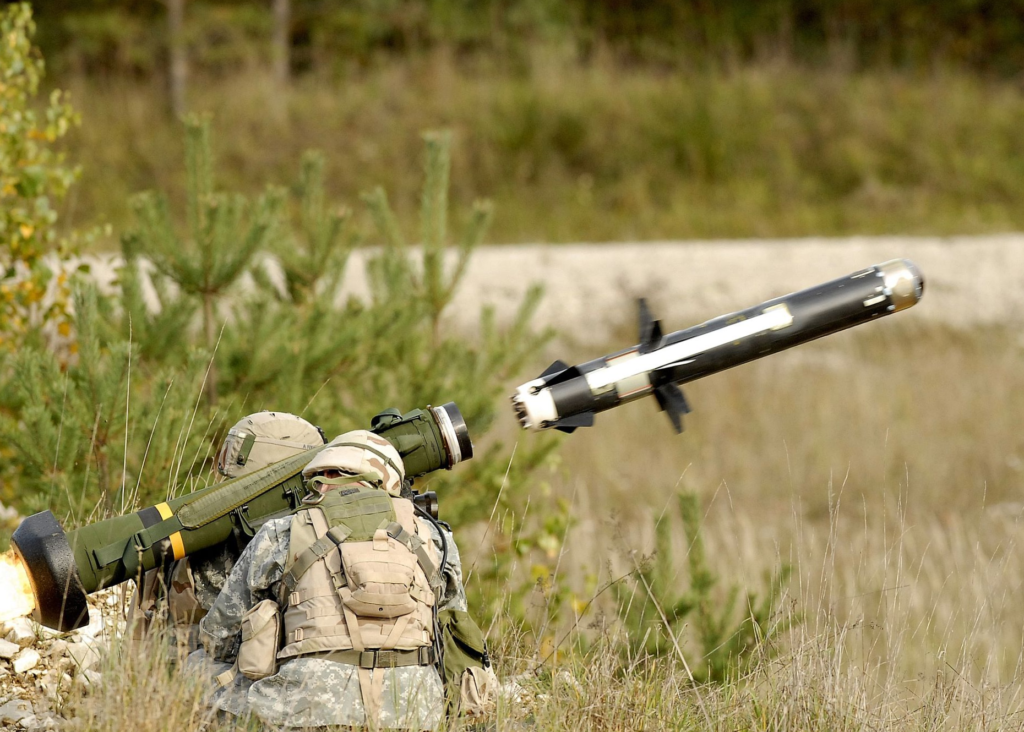The Javelin missile is an advanced anti-tank weapon that enables precision targeting and effective destruction of enemy armored vehicles. It is a powerful and versatile weapon used by military forces around the world.
With its advanced guidance system and long-range capabilities, the Javelin missile provides a reliable means of neutralizing threats on the battlefield. Its compact size and ease of use make it a preferred choice for infantry units and special forces. The Javelin missile’s exceptional accuracy and lethality make it an essential tool for modern warfare scenarios.
The History Of Javelin Missile
The history of the Javelin missile dates back to its development in the 1980s, as a portable anti-tank weapon utilized by the United States military. Its advanced technology and versatility have made it a formidable asset in combat situations.
Development And Introduction
The Javelin missile is an advanced anti-tank weapon that has played a significant role in modern warfare. Developed by Raytheon and Lockheed Martin, this shoulder-fired missile has a fascinating history that spans several decades. Let’s delve into the development and introduction of this remarkable weapon.
In the late 1970s, the United States Army recognized the need for a more effective and versatile anti-tank weapon. The existing systems lacked the capabilities to defeat modern armored vehicles, which were becoming faster and better protected. Thus, the Javelin missile project was initiated, to design an advanced missile system that could effectively neutralize armored threats.
After extensive research and development, the Javelin missile was introduced to the US Army in 1996. It quickly gained recognition for its exceptional performance and reliability, making it the weapon of choice for anti-armor operations. Since then, this missile has been widely adopted by various armed forces around the world and has proven its effectiveness in numerous conflicts.
Key Features And Capabilities
The Javelin missile possesses a range of key features and capabilities that make it one of the most advanced anti-tank weapons in the world. Here are some of its notable characteristics:
- Fire-and-Forget: The Javelin missile is a fire-and-forget system, meaning that once it is launched, the operator can immediately take cover without having to guide the missile to its target. This ensures the safety of the operator while maximizing the effectiveness of the missile.
- Top-Attack Mode: One of the unique features of the Javelin missile is its ability to engage targets from above. It can accurately strike the most vulnerable areas of armored vehicles, such as the roof or engine compartment, where the armor is usually the weakest.
- Thermal Imaging Guidance: The missile is equipped with an advanced imaging infrared seeker, allowing it to accurately track and engage targets, even in challenging environments such as smoke, fog, or darkness. This makes it highly effective during both day and night operations.
- Long Range: The Javelin missile has an impressive range of up to 2.5 kilometers, enabling operators to engage targets from a safe distance. This extended range provides flexibility and allows for effective engagement in various combat scenarios.
- Tandem Warhead: The Javelin missile is equipped with a tandem warhead, consisting of a precursor charge followed by a main warhead. This design allows it to defeat even the most heavily armored vehicles by penetrating the outer layers before detonating the main warhead.
In conclusion, the Javelin missile has a rich history that showcases its development and introduction as a highly capable anti-tank weapon. Its key features and capabilities, such as fire-and-forget operation, top-attack mode, thermal imaging guidance, long-range, and tandem warhead, make it a formidable asset on the battlefield. With its proven track record, the Javelin missile continues to play a vital role in modern warfare, ensuring the protection of troops and the successful neutralization of armored threats.

Credit: www.wsj.com
Understanding The Javelin Missile System
The Javelin Missile System is a highly advanced and versatile anti-tank missile system used by militaries around the world. Its exceptional accuracy and reliability make it an invaluable asset on the battlefield. In this article, we will delve into the components, specifications, and guidance systems that make the Javelin Missile System one of the most sought-after weapons in modern warfare.
Components And Specifications
The Javelin Missile System consists of two main components: the Command Launch Unit (CLU) and the missile itself. The CLU serves as the weapon’s eyes and brain, providing the operator with a direct line of sight to the target and facilitating the missile’s guidance. It features an advanced thermal sight that allows for effective target acquisition and tracking, even in the most challenging conditions.
The missile, on the other hand, is a compact and lightweight weapon that packs a powerful punch. It weighs approximately 22.3 pounds (10.1 kilograms) and is 3 feet 8 inches (1.12 meters) long. Despite its small size, the Javelin missile can reach a maximum speed of Mach 0.95, enabling it to engage targets at distances of up to 2.5 miles (4 kilometers) away.
To ensure optimum performance, the Javelin Missile System is equipped with a tandem warhead. This warhead consists of two separate explosive charges that are detonated in sequence upon impact. The first charge neutralizes any reactive armor on the target, while the second penetrates the main armor, effectively disabling the enemy vehicle.
Guidance And Targeting Systems
The Javelin Missile System incorporates advanced guidance and targeting systems that elevate its effectiveness on the battlefield. It employs a fire-and-forget guidance system, which means that once the missile is launched, the operator can immediately move to a safe position without having to worry about continuously tracking the target. This is made possible by the missile’s Lock-On Before Launch (LOBL) capability, which allows for target lock-on even before the missile is fired.
The Javelin missile’s guidance system consists of both infrared and command guidance elements. The infrared seeker provides the missile with the ability to track and engage targets based on their thermal signatures. This means that the Javelin Missile System is highly effective against both stationary and moving targets, day or night.
In addition, the missile’s command guidance system helps enhance its precision and accuracy. After launch, the operator can steer the missile to its target using a joystick-like control on the CLU. This feature enables the missile to maneuver around obstacles and engage targets from various angles, increasing its versatility in different combat scenarios.
Conclusion
The Javelin Missile System is truly a game-changer in modern warfare. With its cutting-edge components, impressive specifications, and advanced guidance systems, this anti-tank weapon possesses the capability to neutralize even the most heavily armored enemy vehicles. The Javelin’s reliability and effectiveness have cemented its place as an indispensable asset for militaries across the globe.
Deployment And Effectiveness
Javelin Missiles have proven to be a highly effective weapon in military operations around the world. Its deployment and effectiveness have made it an essential tool for the armed forces.
Military Usage And Tactics
The Javelin Missile’s versatile design allows it to be deployed in various military scenarios. Its portability enables soldiers to carry and operate it effectively in different terrains, including urban environments and rugged landscapes. The missile’s ease of use and quick deployment make it an invaluable asset for ground troops.
When it comes to military usage and tactics, the Javelin Missile offers precision and long-range capability. It can engage targets at distances of up to 2.5 kilometers, with its fire-and-forget capabilities ensuring accuracy and reducing the risk to soldiers. The missile’s advanced imaging infrared seeker provides effective target recognition and tracking, even in adverse weather conditions or obscured environments.
The Javelin Missile’s ability to engage both stationary and moving targets gives military forces a significant advantage on the battlefield. Its effectiveness against armored vehicles, bunkers, and fortified positions makes it a go-to weapon for ground forces. The missile’s tandem warhead is specifically designed to defeat reactive armor, increasing its success rate in armored engagements.
Successful Engagements And Impact
Through various successful engagements, the Javelin Missile has demonstrated its impactful capabilities. Its precision and lethality have significantly contributed to the success of military operations.
One notable use of the Javelin Missile was during Operation Iraqi Freedom when it was employed to neutralize enemy armored vehicles and fortified positions. The missile’s high success rate resulted in the elimination of key threats and the disruption of enemy operations. Its ability to engage targets at extended ranges kept soldiers safe while effectively neutralizing enemy assets.
The impact of the Javelin Missile extends beyond conventional warfare. Its deployment in peacekeeping missions has proven valuable in safeguarding stability and protecting innocent civilians. The missile’s accuracy and limited collateral damage minimize risks to non-combatants, ensuring precise engagements in complex operational environments.

Credit: strikeforceheroes.fandom.com
Advancements And Future Prospects
The Javelin missile system has continually evolved and undergone significant advancements in recent years. These advancements not only enhance the weapon’s capabilities but also open up new possibilities for its future use. In this section, we will explore two key areas of advancement: Technological Improvements and Integration with Other Weapon Systems.
Technological Improvements
The Javelin missile system has witnessed remarkable technological improvements, contributing to its effectiveness on the battlefield. One notable advancement is the introduction of advanced guidance systems, which have significantly improved the missile’s accuracy and precision. These guidance systems utilize cutting-edge technology, continuously tracking targets and adjusting the missile’s flight path to ensure successful hits.
Moreover, Javelin missiles now feature improved warhead designs, enabling them to effectively neutralize a wider range of armored targets. These warheads leverage advancements in explosive material and shrapnel dispersal, maximizing damage upon impact. The combination of enhanced guidance systems and improved warhead designs makes the Javelin missile an even more formidable weapon against armored threats.
Additionally, the Javelin missile system has embraced advancements in miniaturization and weight reduction. Through innovative engineering, the system has become more compact and lightweight, enabling greater portability and ease of deployment for military personnel. This improvement enhances the system’s versatility, allowing it to be effectively utilized in various combat scenarios.
Integration With Other Weapon Systems
The Javelin missile system has also made significant progress in terms of integration with other weapon systems. This integration greatly expands the capabilities and flexibility of the system, allowing it to operate synergistically with different platforms and technologies.
One notable integration is the incorporation of unmanned aerial vehicles (UAVs) into the Javelin missile system. By pairing the system with UAVs, operators can gather real-time intelligence and enhance target acquisition capabilities. This integration enables the Javelin missile system to take advantage of a higher vantage point and engage targets more effectively.
Furthermore, the Javelin missile system can be integrated with various sensor technologies, such as thermal imaging and radar systems. These sensors provide enhanced situational awareness and target detection capabilities, enabling operators to engage targets with greater speed and accuracy.
Moreover, the Javelin missile system can be integrated with other ground-based weapon systems, creating a comprehensive defensive or offensive network. This integration allows for coordinated strikes and improved overall battlefield effectiveness.
In conclusion, the advancements and prospects of the Javelin missile system are promising. Technological improvements, such as advanced guidance systems and improved warhead designs, enhance its effectiveness against armored threats. Integration with other weapon systems further expands its capabilities and flexibility. As the Javelin missile system continues to evolve, we can expect it to play an increasingly vital role in modern warfare.
Exploring Alternatives To The Javelin Missile
The Javelin Missile has long been a vital weapon system for modern infantry forces, providing high mobility and effective anti-tank capabilities. However, as technology continues to advance, it becomes crucial to explore alternative options that can match or even surpass the Javelin’s performance. In this article, we will delve into the competing anti-tank systems that exist in the market today, discussing their advantages and disadvantages.
Competing Anti-tank Systems
When it comes to anti-tank systems, several alternatives to the Javelin Missile have emerged over the years. These systems include:
- 1. Spike missile system
- 2. Kornet missile system
- 3. TOW missile system
Advantages And Disadvantages
- Spike Missile System
The Spike missile system is a highly accurate and versatile anti-tank weapon widely used by various military forces. Its advantages include:
- Easy to operate and maintain
- Long-range capabilities
- Advanced target acquisition and fire control systems
Nevertheless, it also has a few disadvantages to consider:
- Costly compared to some other systems
- May require more specialized training for optimal use
- Limited in its portability due to its weight
- Kornet Missile System
Another notable anti-tank system is the Kornet missile system, which offers its own set of advantages:
- Outstanding armor penetration capability
- Flexible usage in various terrains
- Effective against both static and moving targets
However, like any system, it has certain drawbacks:
- Comparatively shorter range than the Javelin Missile
- Can be affected by adverse weather conditions
- Requires more crew members for operation
- TOW Missile System
The TOW missile system has gained recognition for being a widely deployed anti-tank system. Its advantages include:
- Proven effectiveness against heavily armored vehicles
- Reliable wire-guided technology
- Compatibility with a wide range of platforms
However, there are also a few disadvantages to consider:
- Significant weight and bulkiness
- More vulnerable to countermeasures
- Higher cost compared to some alternatives
Exploring alternatives to the Javelin Missile is essential to ensure that military forces have access to the most efficient and effective anti-tank systems available today. By understanding the advantages and disadvantages of these competing systems, decision-makers can make informed choices to meet their operational needs.
Credit: www.wsj.com
Frequently Asked Questions Of Javelin Missile
What Is A Javelin Missile?
A Javelin missile is a portable anti-tank weapon used by the military. It is designed to destroy armored vehicles and fortified positions with high precision. The missile can be fired from a shoulder-mounted launcher and has a range of up to 2.
5 kilometers.
How Does A Javelin Missile Work?
A Javelin missile works by employing a “fire-and-forget” guidance system. It is equipped with an infrared seeker that tracks the heat signature of the target. Once launched, the missile autonomously guides itself towards the target, making mid-course corrections if necessary, and then strikes it with an explosive warhead.
What Are The Advantages Of Using Javelin Missiles?
Using Javelin missiles offers several advantages. Firstly, they have high accuracy and can hit targets with precision, minimizing collateral damage. Secondly, they have a long-range capability, allowing the operator to engage targets from a safe distance. Lastly, Javelin missiles are portable and can be easily carried and deployed by infantry units.
How Effective Are Javelin Missiles Against Armored Vehicles?
Javelin missiles are highly effective against armored vehicles. With their tandem warhead design, they can penetrate even the thickest armor, such as that found on tanks. The missile’s high accuracy and ability to strike the vulnerable top armor of vehicles make it a formidable anti-tank weapon on the battlefield.
Conclusion
To sum up, the Javelin Missile proves to be an indispensable weapon in modern warfare scenarios. Its advanced technology and precision targeting capabilities make it a force to be reckoned with on the battlefield. With its ability to penetrate armored vehicles and neutralize threats from a safe distance, the Javelin Missile ensures the safety and success of military operations.
Stay ahead of the game by harnessing the power of this remarkable weapon.









